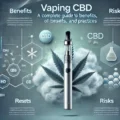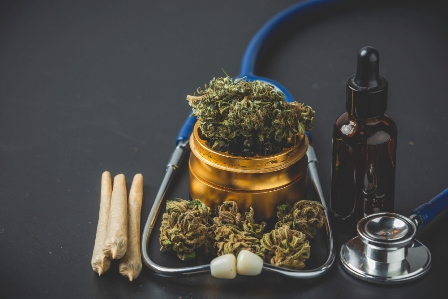Vaping CBD has become a popular method for consuming cannabidiol due to its fast-acting effects and ease of use. However, concerns over its safety, health implications, and the spread of misinformation have left many users uncertain. This guide aims to provide a well-researched overview of the benefits, risks, and common myths surrounding vaping CBD, helping consumers make informed decisions.
How Does Vaping CBD Work?
The Basics of CBD Vaping
Vaping involves heating CBD e-liquid or concentrates into vapor, which is then inhaled through a vape pen or vaporizer. Unlike smoking, vaping does not involve combustion, which is believed to reduce the number of harmful byproducts inhaled.
Types of CBD Vape Products
- CBD Vape Juice (E-Liquid): Designed for use in vape pens and mods, containing CBD, flavoring, and carrier liquids like propylene glycol (PG) and vegetable glycerin (VG).
- CBD Cartridges: Pre-filled vape cartridges that attach to a compatible battery.
- CBD Disposable Vape Pens: Ready-to-use, pre-charged devices containing CBD vape oil.
- CBD Wax or Concentrates: More potent options used in specialized vaporizers for stronger effects.
The Health Benefits of Vaping CBD
1. Fast-Acting Relief
Vaping CBD allows for rapid absorption into the bloodstream through the lungs, making it ideal for conditions requiring immediate relief, such as:
- Anxiety and stress
- Chronic pain and inflammation
- Sleep disorders
2. Higher Bioavailability
Compared to edibles and capsules, vaping provides greater bioavailability, meaning a higher percentage of CBD enters the bloodstream and takes effect more quickly.
3. Convenient and Discreet
Vape pens are portable, easy to use, and produce minimal odor, allowing users to consume CBD discreetly in various settings.
Risks and Health Concerns of Vaping CBD
1. Potential Lung Irritation
Although vaping is generally considered safer than smoking, inhaling any vaporized substance may cause:
- Respiratory irritation, particularly for individuals with asthma or lung conditions.
- Potential long-term effects, which are still being studied.
2. Quality Control Issues
The lack of industry regulation has led to:
- Unsafe additives like vitamin E acetate, linked to severe lung injury.
- Inconsistent labeling, making it difficult for consumers to determine purity and potency.
- Contaminants such as heavy metals and pesticides in poorly sourced CBD.
3. Dependence and Overuse
While CBD is not addictive, some users may become psychologically dependent on vaping for quick relief, leading to excessive use.
Debunking Common Myths About Vaping CBD
Myth 1: Vaping CBD Gets You High
Fact: CBD is non-psychoactive and does not produce a high. However, full-spectrum CBD vape oils may contain trace amounts of THC (under 0.3%), which could have mild effects in sensitive individuals.
Myth 2: All CBD Vape Products Are Safe
Fact: Not all CBD vape oils are created equal. Some contain harmful thinning agents and artificial flavoring, making it essential to choose lab-tested products from reputable brands.
Myth 3: Vaping CBD Has No Side Effects
Fact: While CBD is generally well-tolerated, vaping can cause mild side effects such as dry mouth, dizziness, and short-term throat irritation in some users.
Best Practices for Safe CBD Vaping
1. Choose High-Quality, Lab-Tested Products
Look for CBD vape products that:
- Are third-party lab tested for potency and contaminants.
- Contain no harmful additives like vitamin E acetate or diacetyl.
- Use organic, non-GMO hemp extracts free from pesticides.
2. Start with a Low Dose
For new users, starting with a low dose and gradually increasing it based on tolerance and effects is recommended. Overuse may lead to unwanted side effects such as fatigue or drowsiness.
3. Use the Right Vaping Device
Understanding different vape devices ensures a safer experience:
- Disposable Vape Pens: Beginner-friendly and require no maintenance.
- Refillable Vape Pens: Allow for customization but require proper cleaning.
- Advanced Vaporizers: Provide temperature control for a tailored vaping experience.
4. Avoid Harmful Additives
Check ingredient lists and avoid CBD vape oils containing:
- Vitamin E acetate (linked to lung injuries)
- Diacetyl (associated with lung disease)
- Artificial thinning agents like PG in high concentrations
5. Store CBD Vape Products Properly
To maintain potency and prevent degradation, store vape cartridges and e-liquids in a cool, dry place, away from direct sunlight and heat sources.
Alternatives to Vaping CBD
For those hesitant about vaping, alternative CBD consumption methods include:
- CBD Tinctures: Administered sublingually for fast absorption.
- CBD Edibles: Gummies and capsules offering a slower but long-lasting effect.
- CBD Topicals: Creams and balms applied directly to the skin for localized relief.
- CBD Patches: Provide sustained-release CBD without inhalation.
Conclusion
Vaping CBD offers fast-acting effects, high bioavailability, and convenience, making it an attractive option for many users. However, concerns over product quality, potential lung irritation, and unregulated ingredients highlight the need for careful product selection. By following safe vaping practices, choosing reputable brands, and staying informed about CBD health research, consumers can enjoy the benefits of vaping CBD while minimizing potential risks.




